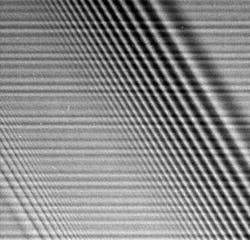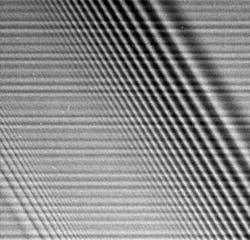Cassini sees in many ways
Loaded with imaging systems and other optoelectronics, the Cassini spacecraft has arrived at Saturn and is there to stay. After closely imaging Phoebe, an outer moon of Saturn, the spacecraft inserted itself into orbit around Saturn on June 30. On Dec. 25, the Huygens probe will be released; three weeks later it will plunge through the atmosphere of Titan, Saturn's largest moon, and wind up either on land or, possibly, floating in a methane sea.
Cassini's Imaging Science Subsystem (ISS) contains two imaging systems: a wide-angle camera that relies on a 57-mm-aperture refracting telescope with a 3.5° field of view and an angular resolution of 60 µrad/pixel, and a narrow-angle camera that has a Cassegrain telescope with a 0.35° field of view and an angular resolution of 6.0 µrad/pixel. Both have filter wheels, with 18 filters ranging from 380 to 1100 nm for the wide-angle camera, and 24 from 200 to 1100 nm for the narrow-angle camera; both also have 1024 × 1024-pixel CCD detectors. The ISS is providing the sweeping planetary, moon, and ring images already familiar to the public (see figure).
This close-up image of a tiny portion of Saturn's rings was taken by Cassini's ISS narrow-angle camera in full-spectrum visible light at a distance of 28,856 km just before the spacecraft passed through the rings. The images were taken from the dark side of the rings at a resolution of 50 to 150 m/pixel. Here, the subtle effects of gravity-related resonances have produced density waves in the rings that create the illusion of receding to infinity (the uniform horizontal bands are not ring features, but are artifacts stemming from the imaging process).
The Visual and Infrared Imaging Spectrometer (VIMS) on Cassini is a mapping spectrometer that will measure reflected and emitted radiation from atmospheres, rings, and surfaces; its visible and IR channels each have a 32-µrad2 field of view. The visible channel is sensitive from 0.35 to 1.07 µm and has a Cassegrain telescope, spectrometer grating, 256-element linear indium antimonide array focal-plane assembly, and two-axis scanning mirror. The IR channel of VIMS is sensitive from 0.85 to 5.1 µm and consists of a Shafer telescope, grating, 256 × 512-pixel silicon CCD area-array focal-plane detector, and single-axis scanning mirror.
Cassini's Composite Infrared Spectrometer (CIRS) is a telescope equipped with dual interferometers to measure IR and terahertz wavelengths from 7 µm to 1 mm emitted by atmospheres, rings, and surfaces. The CIRS will map the global temperatures of Titan and the composition and thermal characteristics of Saturn's rings and satellites.
The Ultraviolet Imaging Spectrograph (UVIS), has four telescope channels. The extreme-ultraviolet channel of UVIS has a 3.67° × 0.34° field of view, an aberration corrected toroidal grating, and an imaging microchannel-plate detector; the far-ultraviolet channel is similar but for design details. The high-speed photometer channel will measure stellar-ring and atmospheric occultations with its photomultiplier-tube detector. The hydrogen-deuterium absorption cell channel will measure Lyman-Alpha emission, and thus the relative abundance of hydrogen and helium, using resonance absorption cells.
The lone optical instrument on the Huygens probe is the Descent Imager/Spectral Radiometer (DISR), which has several subsystems. One IR and two visible sensors will take up to 1100 images of Titan's surface as the probe descends, while a side-view imager will capture the horizon and the bottom layer of clouds. Solar sensors will measure scattering by aerosols in the atmosphere; spectroscopic measurements of the moon's surface will be aided by a lamp that will be switched on shortly before landing. The Huygens probe is expected to operate for only a few minutes after it lands or splashes down.
The Cassini spacecraft mission includes 74 orbits of Saturn and 45 close flybys of Titan. Along with many flybys of Saturn's other moons at distances of 100,000 km or less, eight very close flybys of these moons will occur—three for Enceladus and one each for Phoebe (already accomplished), Hyperion, Dione, Rhea, and Iapetus.

